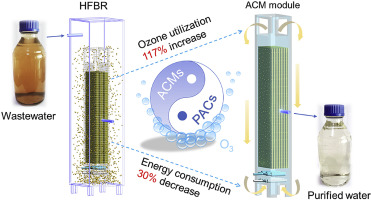当前位置:
X-MOL 学术
›
Water Res.
›
论文详情
Our official English website, www.x-mol.net, welcomes your
feedback! (Note: you will need to create a separate account there.)
A hybrid fluidized-bed reactor (HFBR) based on arrayed ceramic membranes (ACMs) coupled with powdered activated carbon (PAC) for efficient catalytic ozonation: A comprehensive study on a pilot scale.
Water Research ( IF 11.4 ) Pub Date : 2020-01-24 , DOI: 10.1016/j.watres.2020.115536 Kajia Wei 1 , Zhuo Wang 1 , Changpei Ouyang 1 , Xiaoxin Cao 1 , Peng Liang 1 , Xia Huang 1 , Xiaoyuan Zhang 1
Water Research ( IF 11.4 ) Pub Date : 2020-01-24 , DOI: 10.1016/j.watres.2020.115536 Kajia Wei 1 , Zhuo Wang 1 , Changpei Ouyang 1 , Xiaoxin Cao 1 , Peng Liang 1 , Xia Huang 1 , Xiaoyuan Zhang 1
Affiliation

|
Taking advantage of the high mass transfer in the bulk solution of fluidized-bed reactor (FBR), and the benefits of simultaneous particle separation and ozone catalysis on ceramic membranes, we proposed a hybrid fluidized-bed reactor (HFBR) based on arrayed ceramic membranes (ACMs) coupled with powdered activated carbon (PAC) for efficient catalytic ozonation. The optimum HFBR performance on a pilot scale was found at PAC addition of 3 g/L, ozone dosage of 25 mg/L, hydraulic retention time of 60 min and auxiliary aeration strength of 5 m3/h. During the 30-day treatment of coal-gasification secondary effluent (200 L/h), the HFBR system revealed not only a 117% increase in ozone utilization efficiency (ΔCOD/ΔO3) upon pure ozonation but also a highly purified effluent with better sterilization and low residual bromate (∼11 μg/L). Low-molecular-weight organic fragments and acids, as well as phthalate esters were identified as the main products in this process. By density functional theory (DFT) calculations, it was found the main functional groups (carbonyls, -C=O) on the PAC could be protected from direct ozonation in the presence of ozone-degradable organics (e.g. phenolic and aliphatic compounds) in the wastewater through an ozone-competing reaction, which prevented the rapid inactivation of the PAC in catalytic ozonation. A longer service life and cheaper materials for ceramic membranes would benefit low operation costs for the HFBR. Moreover, the addition of PAC could greatly reduce ozone demand by ∼60% in the HFBR, and therefore decrease energy consumption by ∼30%. Hence, the HFBR was proved to be a highly competitive technology for wide application in the near future.
中文翻译:

基于阵列陶瓷膜(ACM)和粉状活性炭(PAC)的混合流化床反应器(HFBR),用于高效催化臭氧化:中试规模的综合研究。
利用流化床反应器(FBR)本体溶液中的高质量传质以及在陶瓷膜上同时进行颗粒分离和臭氧催化的优势,我们提出了一种基于阵列陶瓷膜的混合流化床反应器(HFBR) (ACM)与粉末状活性炭(PAC)结合使用,可实现高效的催化臭氧化。在添加3 g / L的PAC,25 mg / L的臭氧量,60分钟的水力停留时间和5 m3 / h的辅助曝气强度后,发现了中试规模的最佳HFBR性能。在煤气化二级废水(200 L / h)的30天处理过程中,HFBR系统不仅显示纯臭氧化后的臭氧利用效率(ΔCOD/ΔO3)提高了117%,而且还显示了具有更好灭菌效果的高纯度废水残留的溴酸盐低(〜11μg/ L)。低分子量有机碎片和酸以及邻苯二甲酸酯被确定为该过程的主要产物。通过密度泛函理论(DFT)计算,发现PAC中的主要官能团(羰基,-C = O)在存在可臭氧降解的有机物(例如酚和脂族化合物)的情况下可以防止直接臭氧化。臭氧竞争反应产生的废水,阻止了催化臭氧化过程中PAC的快速失活。更长的使用寿命和更便宜的陶瓷膜材料将使HFBR的运行成本降低。而且,添加PAC可以大大减少HFBR中的臭氧需求约60%,因此可以减少约30%的能耗。因此,
更新日期:2020-01-26
中文翻译:

基于阵列陶瓷膜(ACM)和粉状活性炭(PAC)的混合流化床反应器(HFBR),用于高效催化臭氧化:中试规模的综合研究。
利用流化床反应器(FBR)本体溶液中的高质量传质以及在陶瓷膜上同时进行颗粒分离和臭氧催化的优势,我们提出了一种基于阵列陶瓷膜的混合流化床反应器(HFBR) (ACM)与粉末状活性炭(PAC)结合使用,可实现高效的催化臭氧化。在添加3 g / L的PAC,25 mg / L的臭氧量,60分钟的水力停留时间和5 m3 / h的辅助曝气强度后,发现了中试规模的最佳HFBR性能。在煤气化二级废水(200 L / h)的30天处理过程中,HFBR系统不仅显示纯臭氧化后的臭氧利用效率(ΔCOD/ΔO3)提高了117%,而且还显示了具有更好灭菌效果的高纯度废水残留的溴酸盐低(〜11μg/ L)。低分子量有机碎片和酸以及邻苯二甲酸酯被确定为该过程的主要产物。通过密度泛函理论(DFT)计算,发现PAC中的主要官能团(羰基,-C = O)在存在可臭氧降解的有机物(例如酚和脂族化合物)的情况下可以防止直接臭氧化。臭氧竞争反应产生的废水,阻止了催化臭氧化过程中PAC的快速失活。更长的使用寿命和更便宜的陶瓷膜材料将使HFBR的运行成本降低。而且,添加PAC可以大大减少HFBR中的臭氧需求约60%,因此可以减少约30%的能耗。因此,











































 京公网安备 11010802027423号
京公网安备 11010802027423号